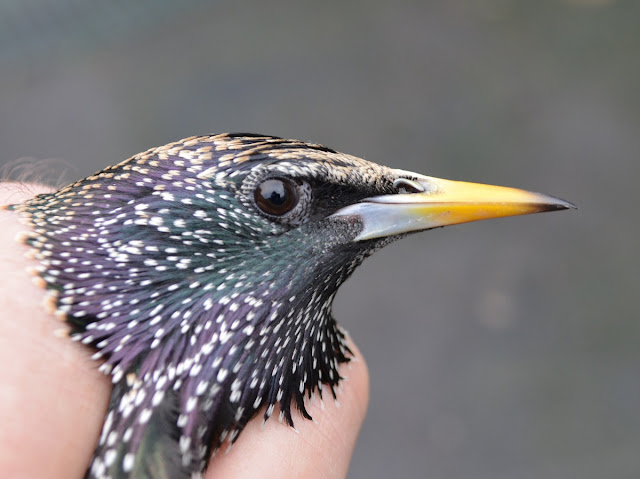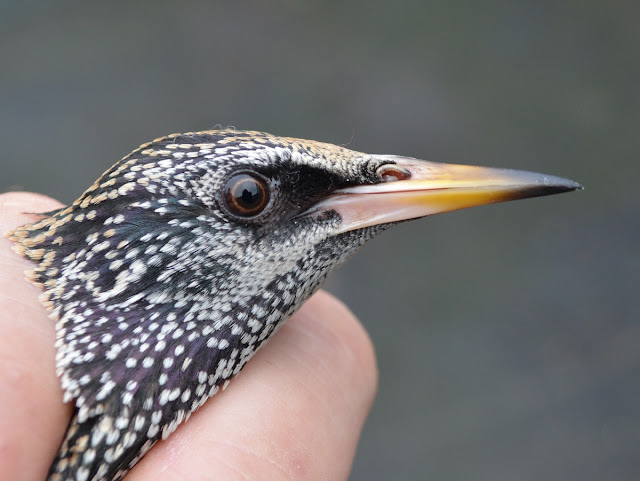It may have been a bit chilly today and is forecast to be colder tomorrow but it has been another relatively mild winter so far. Many birds are starting to show territorial activity now that the days are getting longer and species like Mistle Thrush, Song Thrush, Starling and Great Tit have been singing, on and off, for a week or two now.
Whilst watching the birds in the garden this morning I noticed a Collared Dove flying into some ivy about 6 metres up a tree and I suspected it had joined another that was already there. The ivy clad tree is in the park just across the road from the front garden and I had seen a Collared Dove visit the same location a few days ago, so I began to think it was a pair that could be nest building or at least prospecting.
I watched for a while and saw that one bird kept flying down to the ground and then going back up to the same location in the tree, and although it was a bit too far away for me to be sure I thought it had carried some nest material on at least one occasion. I decided to check it out so I grabbed my camera and went for a closer look.
On entering the park I could see what I presumed to be the male Collared Dove searching for fine twigs along the side of the path. There were loads of fine birch and alder twigs on the ground for it to choose from but it was fussier than I expected. It would pick up a twig and then discard it and then go on to another. This process was repeated several times before it found one it deemed to be suitable which it then took up to its partner at the nest site in the ivy.
The other Collared Dove, presumably the female, stayed at the nest site and arranged the twigs that were brought by its partner. Given that a Collared Dove nest is usually a fairly flimsy platform of twigs there was a lot of careful placement, turning around and treading of the twigs into place. Although the nest is well concealed on a branch in the ivy it appeared to be quite substantial by Collared Dove standards and probably not far off completion.
Collared Doves have been recorded nesting throughout the year where food is abundant, although breeding activity is generally much reduced in winter. Day length probably has a part to play in reducing winter breeding activity in the UK rather than a shortage of food as there is likely to be a greater and more reliable supply of food from garden feeding through the winter than at other times of year.
While it may not be unheard of to find a pair of Collared Doves nest building in late January it is still relatively uncommon in this area and a welcome sign of spring.
Wednesday, 25 January 2017
Sunday, 22 January 2017
Garden ringing and a big bill.
I haven't posted anything about my ringing activities so far this year but that doesn't mean I have been sitting on my hands. Much of my effort has been focused on the garden and Starlings in particular. The fat cakes have been attracting far more Starlings than I usually get in winter (despite the generally mild conditions) which has allowed me to get a lot of resightings of birds that were colour-ringed as part of my RAS project and also ring a good number of new birds. Yesterday was no exception with 9 colour-ringed Starlings recorded and another 4 new birds ringed.
Most Starlings can now be sexed from their bill colour with males having a blue base to their bill and females having a pink pink base to an otherwise similarly yellow bill. Some birds, all probably 2cy+, were showing these breeding season colours before the end of December but the rest are catching up now. There are other differences between the sexes with the colour of the eye being another useful feature and one that works for most individuals throughout the year. Males generally have an evenly coloured brown iris whilst females usually show a pale orbital ring within the brown iris.
Whilst watching the Starlings yesterday I noticed one with a deformed bill that I hadn't seen before. The lower mandible was much longer than normal while the upper mandible was quite a bit shorter than usual. It had a unique way of feeding on the fat cakes and slid the lower mandible along the side of the fat cake which allowed it to nip bits off when the upper mandible made contact with the fat cake.
Luckily it went into the bird table trap and I was able to catch it. The upper mandible looked like it had suffered some sort of damage which had allowed the lower mandible to over-grow. Normally the upper mandible overlaps the lower at the tip and, along with normal wear from feeding, helps to prevent this sort of deformity.
It's not just Starlings that I have been watching and ringing as the other feeders have been attracting large numbers of birds and Goldfinches in particular. There are 7 seed feeders around the garden and the birds are currently getting through over a kilo of sunflower hearts each day.
This morning I took advantage of the calm and overcast conditions and a short session with the usual 6m net resulted in a catch of 33 birds (18 new birds and 15 retraps). This was made up as follows (retraps in brackets): Goldcrest 1; Blue Tit (1); Great Tit 1; Long-tailed Tit 1 (4); Robin 1; Goldfinch 11 (9); Siskin 3 (1).
 |
| D61 is a frequent visitor to the fat cakes at the moment and was ringed as a juvenile last summer. |
 |
| Male Starling 21/01/2017 |
 |
| Female Starling 21/01/2017 |
Luckily it went into the bird table trap and I was able to catch it. The upper mandible looked like it had suffered some sort of damage which had allowed the lower mandible to over-grow. Normally the upper mandible overlaps the lower at the tip and, along with normal wear from feeding, helps to prevent this sort of deformity.
 |
| Male Starling with deformed bill 21/01/2017. |
 |
| Male Starling with deformed bill 21/01/2017. |
It's not just Starlings that I have been watching and ringing as the other feeders have been attracting large numbers of birds and Goldfinches in particular. There are 7 seed feeders around the garden and the birds are currently getting through over a kilo of sunflower hearts each day.
 |
| The scene around one of the 7 sunflower heart feeders yesterday. |
 |
| Male Goldfinch 21/01/2017 |
 |
| Adult male Siskin 21/02/2017 |
Friday, 20 January 2017
Scarlet Elf Cup
I was talking to a couple of people the other day that had been looking at some fungi and I happened to mention that it wouldn't be long before there should be plenty of Scarlet Elf Cup showing. Well a few days on and I came across a cracking display of this brightly covered fungi in a local wood. The literature says it can be found from early winter through to early spring but I usually come across it in second half of that period, and February and March in particular.
It is one of those things that always cheers me up when I see it and I just can't resist taking photographs of it.
 |
| A cheery bit of brightness on what was a very dull day |
 |
| The best display was in this tangle of dead branches. They aren't obvious at this distance but you can just make out a few amongst the moss in the foreground.. |
 |
| Get in a bit closer and there are some on nearly every branch. |
 |
 |
It is one of those things that always cheers me up when I see it and I just can't resist taking photographs of it.
Friday, 6 January 2017
Goldcrest recoveries
A couple of Goldcrest recoveries landed in my inbox today and although one went much further than the other both are interesting in their own way.
JDH982 was ringed on 09/10/2015 on Billinge Hill and was one of 15 caught that morning. It was controlled just over a year later on 20/10/2016 at Oxwich Marsh, near Swansea (237km SSW) by Gower Ringing Group. I follow the Gower Ringing Group blog and it was one of 29 Goldcrests they caught that morning with the control Goldcrest being overshadowed by the capture of a Little Bunting. A link to their blog post for that day can be found here.
The other recovery was over a much shorter distance but is no less valuable because of that as it adds to the picture of movements of this diminutive species. KAD115 was ringed on 30/10/2016 on Billinge Hill and was one of 19 Goldcrests ringed that morning. It was controlled 8 days later on 07/11/2016 at Woolston Eyes, near Warrington (18km SE) by Merseyside Ringing Group. A link to MRG website can be found here.
Links to previous Goldcrest recoveries and controls and be found here, here, here and here.
JDH982 was ringed on 09/10/2015 on Billinge Hill and was one of 15 caught that morning. It was controlled just over a year later on 20/10/2016 at Oxwich Marsh, near Swansea (237km SSW) by Gower Ringing Group. I follow the Gower Ringing Group blog and it was one of 29 Goldcrests they caught that morning with the control Goldcrest being overshadowed by the capture of a Little Bunting. A link to their blog post for that day can be found here.
The other recovery was over a much shorter distance but is no less valuable because of that as it adds to the picture of movements of this diminutive species. KAD115 was ringed on 30/10/2016 on Billinge Hill and was one of 19 Goldcrests ringed that morning. It was controlled 8 days later on 07/11/2016 at Woolston Eyes, near Warrington (18km SE) by Merseyside Ringing Group. A link to MRG website can be found here.
Links to previous Goldcrest recoveries and controls and be found here, here, here and here.
Subscribe to:
Comments (Atom)
















